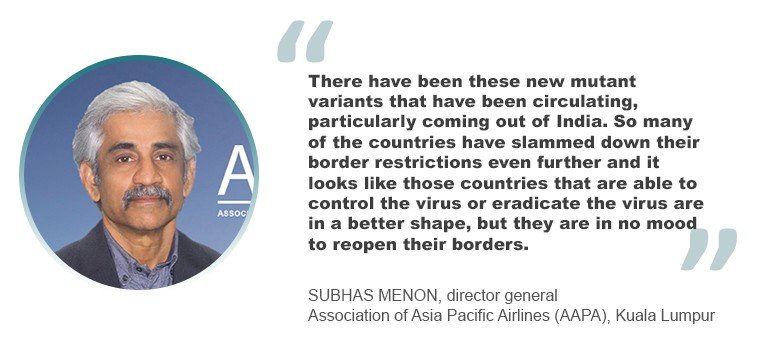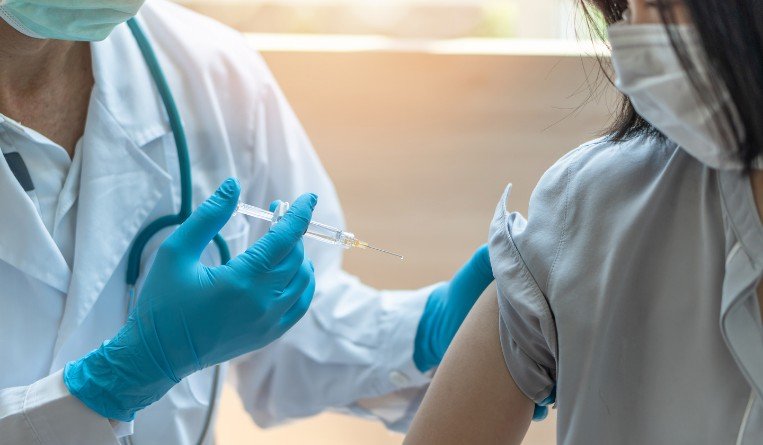Air cargo will remain the “silver lining” of the aviation sector in the Asia Pacific region as recovery in passenger demand continues to be hampered by the slow vaccination rollout as well as the recent spike in Covid-19 cases across the region.
Subhas Menon, director general of the Kuala Lumpur-based Association of Asia Pacific Airlines (AAPA), said contrary to the current state of travel and tourism, overall, rising business confidence and e-commerce growth fuels air cargo demand – coupled with congestion at shipping ports, which has been spurring a shift to the speedier transportation of goods by air.
“I think the only silver lining in the cloud is cargo, because the demand for cargo has just skyrocketed and because of a reduction in capacity, the use has also shot up,” the AAPA chief told a recent CAPA Live event.
APAC airlines ‘doing worse’
He noted, however, that despite this, the contribution of cargo remains relatively small and is unable to fully cover for the losses and mounting cash burn of carriers in the region as flights remain largely grounded due to persisting restrictions related to the coronavirus.
“The cash burn from the airlines in 2020 came out at close to 40% of the total losses of the airline industry,” Menon said. “Asia Pacific airlines are doing worse than the airlines of other regions. And, of course, the level of restrictions in border closures is much higher in Asia than anywhere else.”
“Cargo is not going to make a lot of difference when it comes to cash burn and losses,” he added.
The latest data from AAPA showed preliminary traffic figures for cargo demand continuing its upward momentum, with Asia Pacific airlines recording a 42% year-on-year increase in international air cargo demand for April, topping the 16.1% growth in March which was also the “best performing month” since December 2019. In February, cargo demand was also up 7.6% year-on-year on the back of an acceleration in trade activity.
“When we spoke last, there was an air of optimism, mainly because of vaccines, but the vaccine deployment everywhere else [has been slow]. It’s below 10% even in Australia. So that is one of the reasons why I think the mood is a bit more despondent,” he added, noting Singapore as an exception with at least 25% of its population already fully vaccinated.
Slow vaccination rollout
Mario Hardy, CEO of the Pacific Asia Travel Association (PATA) in Bangkok, noted that the main issue is the relatively sluggish vaccination rollout in the region.
“Most countries in Asia have acquired sufficient vaccines, but they have a different pace of actually vaccinating people,” Hardy said. “So, we’re getting concerned with the rate of vaccination hitting [each] country. Our hope is that countries start to realize that it's important to accelerate it so that we can start to reopen,” he added.
Menon also cited how new variants of Covid-19 are adding more risks to the already struggling aviation sector, further dragging earlier expectations of border re-openings at least across the region sooner rather than later.
“There have been these new mutant variants that have been circulating, particularly coming out of India. So many of the countries have slammed down their border restrictions even further and it looks like those countries that are able to control the virus or eradicate the virus are in a better shape, but they are in no mood to reopen their borders,” Menon added.

Peter Harbison, chairman emeritus of CAPA, shared Menon’s sentiment, and noted how the positive recovery outlook earlier cited by aviation officials could now happen more slowly than expected.
“We’re definitely [looking at] a very, very different story from where we were a couple of months ago,” Harbison told the CAPA Live event.
“I think the feeling then was fairly much of optimism and well, [that] the worst is past. It’s probably not where we stand now,” he added.
Government support still needed
The aviation officials noted that the current situation of airlines also means that the industry will likely need more government support to stay afloat.
“I think the debt burden is increasing for the airlines and the debt is about, I would say maybe five or six times the losses that they are incurring. I think they will require a lot of help from governments in order to stay in the game,” AAPA’s Menon added, as he cited the need for airlines to keep flying, especially during the pandemic when there’s huge demand to move life-saving shipments.
“I think [our] members are all talking seriously with their governments. At the moment, the governments have been quite forthcoming in their support, and then they are hoping that this would carry on,” he added. “The airlines are still playing a major role in terms of transportation of essential supplies and vaccines, so I think governments see the value of airlines being around.”
Nonetheless, in terms of border re-openings in the region, Menon said it will be “unrealistic” to seek relaxation of border controls immediately, citing the need to harmonize health regulations first.
Meanwhile, Hardy said recovery is still on the horizon and “will happen,” although he said that the timeline would differ from earlier expectations.
“I don’t think it’s going to happen to the timeline that people expected. I think they were too ambitious with their goals,” he said. “I think it’s going to take a much longer period.”
He noted that “2022 looks more promising,” rather than previous expectations of a bounceback in 2021.
“I think a few months ago, some of us were maybe a bit more optimistic, but certainly in the last couple of weeks, for several countries around the region here, they’re not so optimistic anymore,” Hardy said.
Charlee C. Delavin



